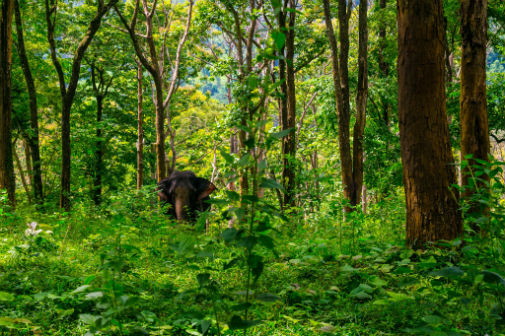Tropical forest protection schemes fail to compete with rubber plantations
Posted on 2 March 2018

Forests are worth a lot to climate change mitigation efforts.
Carbon credit schemes are being developed across Southeast Asia to protect tropical forests. The schemes offer financial incentives to reduce deforestation and forest degradation because trees help to offset carbon emissions by absorbing and storing CO2.
The authors of the study warn that unless payments for forest carbon credits are increased, cutting forests down will remain more attractive than protecting them.
Carbon credits are currently priced at $5-$13 per tonne of CO2 on carbon markets. But this doesn’t match the real break-even cost of safeguarding tropical forests from conversion to rubber in mainland Southeast Asia – between $30-$51 per tonne of CO2.
The research was led by Dr Eleanor Warren-Thomas, a Research Associate in the Department of Biology at the University of York, as part of her PhD research at the University of East Anglia. The study was carried out in collaboration with scientists from the universities of Copenhagen, Exeter, Oxford and Sheffield, and the Wildlife Conservation Society.
Dr Warren-Thomas, said: “Forests are being converted into rubber plantations in Southeast Asia – especially in Cambodia, China, Laos, Myanmar and Vietnam.
“Rubber production covers a massive area – 8.6 million hectares – and demand for natural rubber, driven by the tyre industry, has driven this expansion.
Irreplaceable
“It’s a big problem because these forests are irreplaceable. They are globally unique ecosystems, supporting many threatened animals, birds and plants, as well as exceptionally valuable luxury timbers such as rosewood. They are also worth a lot to climate change mitigation efforts.”
The service forests provide by absorbing and storing carbon is so important that financial incentives to prevent deforestation were included in the Paris Agreement at the COP21 international climate negotiations in 2015.
The research team focused on Cambodian forests, where trees grow as high as 55 metres, and investigated whether carbon credits are enough to safeguard the forests by working out the amount of carbon held by the trees, and the amount of profit which could be made by logging and conversion to rubber.
The team went on to calculate how much each tonne of CO2 should be priced at to match foregone profits from timber and rubber profits – the ‘break-even’ carbon prices.
Threat
Warren-Thomas added: “Forests are less likely to be protected using carbon finance if the payments coming in are much lower than the profits the forest would generate if cut down. We show that where demand for land for rubber plantations is driving deforestation, carbon payments are unlikely to appear an attractive alternative.
“The threat of rubber could be reduced by the zero-deforestation pledges that have already been made by big tyre companies, government regulations, or enforcement of existing forest protection laws. But ultimately, the demand for natural rubber might only be mitigated by further development of synthetic alternatives or improvements in recycling natural rubber.”
‘Protecting tropical forests from the rapid expansion of rubber using carbon payments’ is published in the journal Nature Communications.
Explore more news

Climate change set to take over as key driver of biodiversity loss by 2050, experts warn
Thursday 25 April 2024

Conservation actions are effective at halting and reversing biodiversity loss, study reveals
Thursday 25 April 2024

More than a quarter of people with Covid infection develop Long Covid, new research reveals
Thursday 25 April 2024
.jpg)
University of York awarded £1.1 million to lead the first stage of UK’s first comprehensive study on devolution and social security
Thursday 25 April 2024

More hybrid and nature-based solutions are urgently need to protect coastal communities from climate change
Wednesday 24 April 2024
Media enquiries
About this research
The research was led by Dr Eleanor Warren-Thomas, a Research Associate in the Department of Biology at the University of York. The study was carried out in collaboration with scientists from the universities of Copenhagen, Exeter, Oxford and Sheffield, and the Wildlife Conservation Society.
